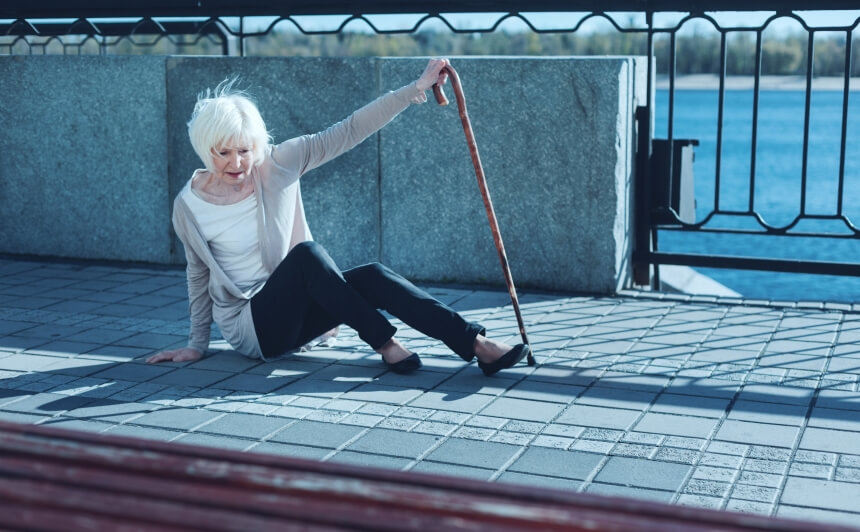
Falls in Old Age – Prevention and Safety for an Active Life
Falls in old age are rightly feared, but in many cases they can be prevented through proper fall prevention. The risk of falling increases significantly after a certain age. A study by the Robert Bosch Hospital in Stuttgart showed that about 30 percent of people over 65 fall at least once a year. These age-related falls often result in injuries – ranging from bruises and lacerations to hip fractures or other injuries that require a hospital stay.
Seniors who have fallen once or more often struggle with psychological issues. They may develop a fear of falling, which prevents them from effectively participating in daily life. Those who fear sudden falls often significantly restrict their daily movement. Affected individuals may barely dare to leave their living area. However, lack of movement and the resulting neglect of social contacts and physical activity tend to worsen the problem. Why does the tendency to fall increase with age and what can you do about it?

In this blog post, we address the causes of falls in old age as well as the possible consequences and provide tips on how to reduce the risk of falling. Simply click on the section that interests you the most.
- Why do older people often fall?
- Fall risk due to biological reasons
- Fall risk due to environmental factors
- Falls in old age due to negligence or misconduct
- Who is considered at risk of falling?
- What consequences can falls in old age have?
- What can I do to avoid falls?
- Measures that at-risk individuals can take themselves
- What to do if a fall has occurred?
- Conclusion
Why do older people often fall?
The risk of falling is generally higher in old age because certain age-related conditions can impair balance, physical strength, or limb coordination. Additionally, illnesses and the effects of injuries or surgeries can increase the risk of falling. "Old age" is not a clearly defined state – whether and which ailments affect us in senior years varies greatly from person to person. Accordingly, falls in old age can be attributed to many different reasons. Often, a combination of various factors leads to a fall.
Therefore, fall prevention always consists of a whole range of measures to protect those affected as comprehensively as possible from dangerous falls. Identifying the dangers in time is the first step to effective prevention. In the following section, you will learn more about the most important factors that favor falls in old age.

Fall risk due to biological reasons
With increasing age, muscle strength, vision, and hearing decline. Various age-related diseases affect our mobility and senses, and even the medications used to counteract age-related ailments can have side effects that increase the risk of falling in old age. Decreased strength and coordination make it difficult to break a fall to avoid injuries. Our own biology literally trips us up.
Check for yourself whether you or your relatives have one or more of the following biological factors for falls in old age.
- Balance problems: Our sense of balance is located in the inner ear. There, fluid-filled semicircular canals and vestibular sacs are located. With each movement, this fluid flows over fine sensory hairs that signal the brain the position of the body and how fast we are moving. As we age, the balance organ reacts more slowly. If the sense of balance is disturbed, the brain often registers too late in which body position we are. Rapid movements – such as suddenly standing up – overwhelm the organ, and affected individuals lose their balance or suffer from dizziness. In addition to the resulting risk of falling, it also becomes very difficult to grab onto something or to break the fall. Besides the aging process, medications or illnesses can negatively affect the sense of balance.
- Visual impairments: Various factors can limit vision in old age, from age-related farsightedness to diseases like cataracts or glaucoma. Those who do not see an obstacle cannot avoid it. Vision and eye health should be regularly checked so that sufficiently strong visual aids are worn. If glasses are too weak, there is a risk, among other things, that distances will be misjudged. Visual problems can also cause dizziness.
- Cardiovascular diseases: Diseases that disrupt circulation often also affect the sense of balance. For example, people with low blood pressure often struggle with circulatory weakness up to fainting spells. High blood pressure can also cause dizziness.
- Dementia and other cognitive impairments: Mental illnesses – such as dementia or Alzheimer's – cause confusion and lead to a state of unreliability in which affected individuals lose themselves. They are no longer able to recognize fall hazards. Without professional care and supervision, domestic accidents would be only a matter of time.
- Consequences and symptoms of diseases: Various diseases can significantly disrupt balance, physical strength, or coordination abilities. Parkinson's patients, for example, sometimes lose all control over their movements. Epileptics could also suffer severe falls due to a seizure. The consequences of a stroke often include paralysis, which increases the risk of falling and can only be countered with intensive therapy.
- Side effects of medications: Some medications cause side effects that cloud consciousness, cause dizziness, or slow reflexes. In addition, drugs like sleeping pills and tranquilizers often have a longer-lasting effect on older people, while a younger body processes these substances better. Furthermore, interactions between different medications can occur, disturbing consciousness or balance.
- Weakened muscles: Muscle strength supports the body, keeps it upright, and allows the hands to grab onto railings, for example. If grip strength decreases, this security is missing. Weak muscles in the legs, abdomen, and back reduce the chances of avoiding a fall if you trip over an obstacle. Often, seniors' muscles are so weak that they lack the strength to get up again after a fall. The sense of balance can only do its job if the muscles are supple and strong enough to translate the signals from the inner ear into posture and movement corrections.
- Diabetes: The widespread disease diabetes also increases the risk of falling as a side effect. For example, severe consciousness disturbances up to unconsciousness threaten during hypoglycemia. The diabetic foot – one of the possible long-term complications of diabetes – leads to impaired sensation in the feet. The sense of pain and pressure diminishes, and affected individuals literally lose their footing. In old age, the risk of falling due to diabetes increases further when the disease coincides with other factors described here.
- Osteoarthritis: Osteoarthritis is a wear-and-tear condition that can manifest in various joints of the body with increasing age. The wear or injuries of the joint cartilage cause bones to rub directly against each other. The bone tissue is thus exposed to pathological changes and deformations, causing enormous pain. Hands – especially the finger joints – knees, spine, and hips are particularly often affected. Accordingly, the mobility of affected patients is greatly restricted. Osteoarthritis in the legs affects a stable stance – in the hands, it impairs grip strength and dexterity. Laypeople often confuse osteoarthritis with arthritis. The latter, however, is a joint inflammation that can occur as a result of osteoarthritis, among other things. Arthritis also restricts mobility due to the pain it causes.
- Osteoporosis: The so-called bone loss is a common age-related disease that makes bone tissue porous. While it is normal for the body to lose bone mass with increasing age, this process progresses unnaturally fast with osteoporosis. When bones lose density, they break more easily – in severe cases, even under minor stress. Since the disease often goes unnoticed for a long time, targeted preventive examinations are recommended from the age of 70 onwards.
- Low blood pressure or anemia: Low blood pressure – hypotension – is not dangerous in most cases but can bring impairments that increase the risk of falling. If blood pressure drops sharply, it can lead to rapid heartbeat, dizziness, and other circulatory problems. In rare extreme cases, affected individuals suffer occasional fainting spells. If these symptoms occur at an inopportune moment, such as when no safe seating is nearby, it can lead to a fall, especially in older individuals. Anemia causes very similar symptoms – it is, however, due to a reduced number of red blood cells or a lack of hemoglobin.
- Physical disability: Missing limbs severely limit physical capabilities and can increase the risk of falling. For example, if leg prostheses are not optimally attached, they could slip under load and give way under the weight of the wearer. Those affected by leg amputations often have to learn in extensive therapy to cope with their new reality and move around in everyday life. Various physical disabilities or degenerative diseases also severely limit mobility – an example is multiple sclerosis, which gradually destroys the body's nerve fibers.
Many of the biological factors mentioned above can also occur at a young age. However, with increasing age, their effects become more problematic and overlap with other age-related ailments. It is important to always pay attention to your own health and to be honest with yourself. Many diseases and conditions can be treated – otherwise, there are almost always alternative ways to deal with the changed situation. If you know that you are at a higher risk of falling for biological reasons, it is easier to eliminate risk sources. Because when the body and senses no longer cooperate, even the familiar home can become a dangerous place.
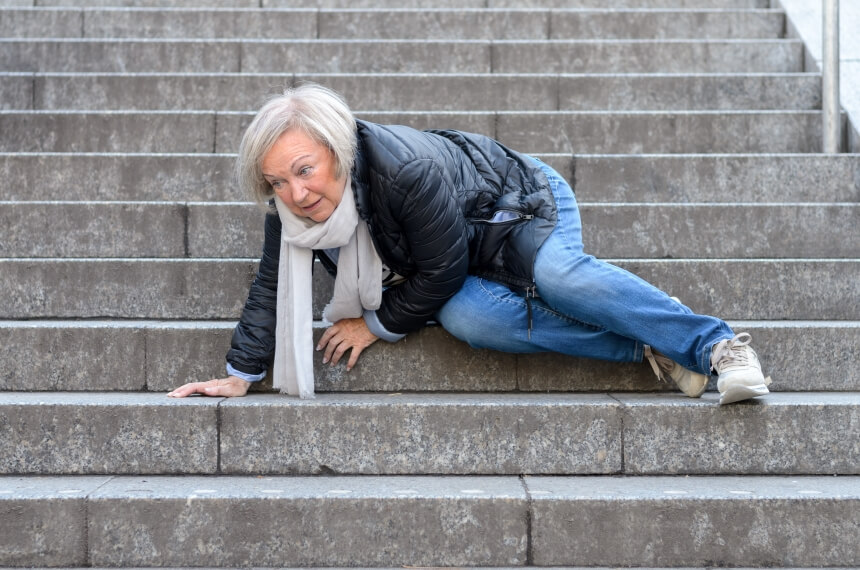
Fall risk due to environmental factors
Many accidents happen in one's own home, as even in a familiar environment, tripping hazards can lurk. Slippery rugs, smooth floors, or steep stairs can naturally befall healthy people of any age – but due to the influence of age-related conditions, the likelihood of overlooking an obstacle or missing a handrail increases. Recognizing potential fall hazards in the immediate environment is therefore important to minimize the risk of falls.
- Tripping hazards: Door thresholds, raised carpet edges, low tables or stools, and scattered objects can trip up even healthy, young people. For seniors with limited coordination and mobility, they become dangerous tripping hazards. If grandchildren are visiting or children live in the house, ensure that no toys are left in the way. Especially balls, skateboards, or toy cars can cause rapid falls if stepped on, as they slide away without resistance.
- Slippery floors and loose rugs: You may know the scene from the famous play "Dinner for One," where Butler James repeatedly trips over the tiger head of an old-fashioned runner. While such floor coverings are rare in today's homes, even simple rugs or the floor itself can promote falls. Ensure that all rugs lie flat and have no wrinkles that feet could catch on. On smooth floors, runners and rugs can be secured with adhesive tape to prevent slipping.
- Fall hotspot bathroom: Bathrooms, particularly showers and bathtubs, pose a high fall risk in old age. Tiled floors or the ceramic surfaces of bathtubs and showers are very slippery when wet. Even healthy, young, and fit people must move carefully here. Seniors lacking the necessary strength and mobility are especially at risk of falling when entering and exiting the shower or bathtub. Later in this article, we will discuss how to make bathrooms, showers, and toilets senior-friendly.
- Stairs: Climbing stairs is strenuous and requires a high level of coordination – something healthy, young people often take for granted. But in old age, it can become very difficult to use stairs as strength and coordination wane and the heart is heavily strained. Falls on stairs are not only frequent – the consequences are often severe. Falling down stairs can cause multiple injuries due to repeated impacts on steps and finally the floor. Therefore, no objects should be placed on the stairs. In many old houses and apartments, there are height differences between rooms bridged by single steps. These are easily overlooked and pose a constant fall risk.
- Improper footwear: Shoes – even "slippers" and house shoes – should fit snugly and not wobble. Poorly fitting shoes slip off too easily and become tripping hazards themselves. Flip-flops and similar sandals are particularly poor footwear for people at risk of falling. They slip off the foot too quickly and can catch on obstacles – especially when walking backward. If special shoes are required due to a condition – such as diabetes – they should be precisely fitted by an expert. Although shoes should fit snugly, they should never cause pressure points or restrict blood flow. Many socks also pose a fall risk when walking on smooth floors. It is advisable to wear socks with non-slip soles.
- Inappropriate clothing: Very loose clothing, wide sleeves, or "baggy pants" may be comfortable but carry the risk of catching on edges or door handles. Those already struggling with balance can quickly stumble.
- Inadequate lighting: If you cannot see an obstacle, you cannot avoid it. Therefore, ensure good lighting in all rooms and hallways. Stair steps, edges, and thresholds in the home can be marked with glow strips to make them visible even in poor lighting or darkness.
- Fall risk in public spaces: Tripping hazards in one's home can be identified or eliminated. It’s different when leaving the house. Not all buildings are yet designed to be accessible. Stairs, escalators, steep pathways, electric scooters haphazardly parked on sidewalks, or even tree roots during a forest walk present a constant fall risk. Nevertheless, it is important and healthy to move outdoors. Frequently traversed paths could be walked with another person to identify potential fall risks and memorize them. Walking aids from canes to walkers compensate for lack of balance, strength, or endurance.
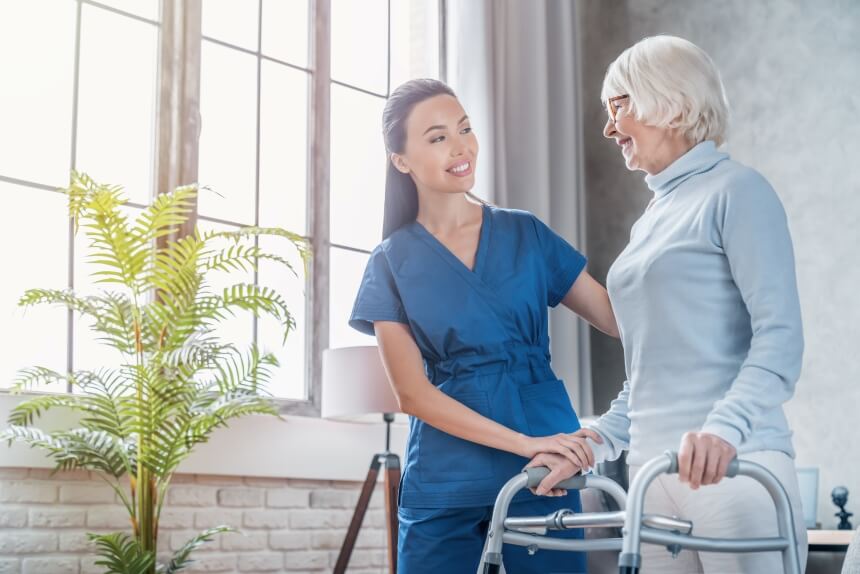
Falls in old age due to negligence or misconduct
Unfortunately, some people are too negligent with their own health, increasing their risk of falling in old age. It is, of course, unpleasant to confront the consequences of aging for oneself. Many older people who have fallen before hide the incident or downplay the danger. The fear of losing control or being patronized by others is often greater than the fear of fall injuries. However, those who ignore the risk of falls in old age expose themselves to a much greater danger.
- Lack of exercise: Too many people exercise too little. Typical "civilization diseases" like back problems or joint wear and tear often originate in youth when, for example, much sedentary work is done without compensatory movement. Those who already suffer pain from simple movements often restrict their activities, worsening the problems. If we do not use our motor skills, they deteriorate over time, so many middle-aged people already suffer from obesity and declining coordination and mobility. Muscles that are too weak cannot sufficiently support the joints and reduce the chances of catching oneself during a fall or getting up without help.
- Alcohol or drug use: Intoxicating substances generally negatively impact balance. Additionally, in an intoxicated state, the ability to recognize tripping hazards is often reduced. Alcohol consumption can lead to overconfidence and dangerous recklessness. Many drugs slow reflexes and confuse the senses. Those at risk of falling should avoid alcohol or drug use or at least significantly limit it. However, some people are forced to take drugs – in the form of medication – due to illnesses. In these cases, it is important that side effects on perception or balance are clarified by a doctor.
- Stubbornness and false pride: Ignoring the danger of falls in old age and excluding oneself from this threat is one of the greatest dangers. Statistics show that one fall often leads to more. Every fall in old age carries the risk of serious injuries and lasting damage. However, many falls could be avoided if those affected openly and honestly dealt with their situation and better prepared for the circumstances of aging.
Falls in old age – various other causes
- Inappropriate or damaged walking aids: Walking aids are only helpful if they are optimally adjusted to the individual and the correct walking aid is chosen for the situation. Walkers or rollators, for example, should be adjusted to the height and length of the arms. The condition of the walking aid should also be constantly monitored. Walking sticks, crutches, or walkers are equipped with non-slip rubber feet. If these wear out, they lose traction and should be replaced promptly. The wheels and brakes of rollators and wheelchairs must also be regularly checked to ensure they move smoothly and do not unlock and roll away when locked.
- Fear of further falls in old age: The fear of falling again after a fall can be almost as dangerous as the fall itself. This can lead to a fatal uncertainty, causing those affected to move less and thus deteriorate their physical condition. In fact, this makes it more likely that further falls will occur.
Who is at risk of falling?
If one or more of the previously described factors apply to you, you may be at risk of falling. Statistically, biological causes of falls increase with age – at the same time, physical and sometimes mental decline increases the danger of tripping hazards in the environment.
Studies by the Stuttgart Robert Bosch Hospital have shown that almost one-third of those over 65 fall at least once a year. From the age of 80, almost every second senior is affected by age-related falls.
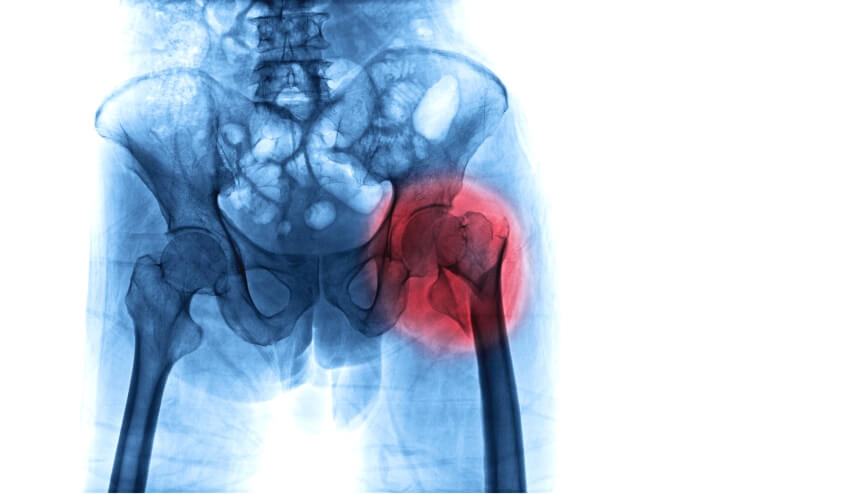
What are the consequences of falls in old age?
Falls in old age can have serious consequences, as our bodies become more susceptible to injuries with increasing age. Skin abrasions, bruises, or sprains – often from trying to catch oneself – are among the milder outcomes. However, injuries frequently occur that require medical treatment. Each year, around 400,000 patients over the age of 65 are treated in German hospitals for fall injuries.
Due to a lack of strength and quick reflexes in old age, many seniors hit their heads when they fall. This can lead to serious injuries ranging from concussions to brain hemorrhages. Since retirees often take blood-thinning medications, such hemorrhages can be particularly dangerous. If paralysis, speech disorders, or confusion occur after a head injury, a brain hemorrhage may be present and must be treated in a hospital as quickly as possible. If the injured person was unconscious for a while, a doctor should also be consulted.
Bone density decreases significantly with age. Therefore, any fall can result in bone fractures. A common fall injury in older people is a femoral neck fracture. The pelvis or coccyx can also be affected, depending on which part of the body bears the brunt of the impact. When falling forward, people usually try to catch themselves with their arms, which can lead to fractures of the ulna and radius, wrists, or elbows. Any bone fracture also carries the risk of bleeding if bone fragments or edges injure the surrounding tissue.
Every fall in old age thus carries the risk of a prolonged hospital stay or even becoming a care-dependent patient. Therefore, take precautions in time to minimize your fall risk or that of your relatives as much as possible.
It should be mentioned that, of course, not only elderly people fall. Many of the causes of falls can lead to a fall at any age – younger people are just more likely to be able to catch themselves without serious injury or recover from its consequences.
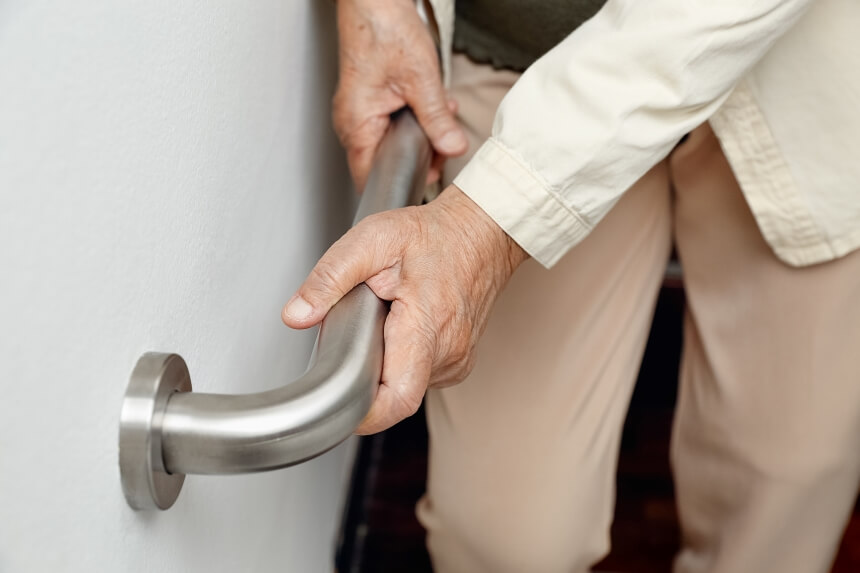
What can I do to prevent falls?
A large part of falls in old age can be prevented with appropriate fall prevention. If individuals at risk of falling are unable to do so themselves due to dementia, senility, physical weakness, or other signs of aging, fall prevention should be managed by family members or care services.
Firstly, thoroughly inspect the home and its immediate surroundings to remove all possible tripping hazards. Remove loose or damaged carpets, clear away loose cables or objects, and check the footwear of those at risk. Carpets and runners can also be made non-slip by using double-sided tape to secure them to the floor.
Special attention should be given to securing the bathroom against fall hazards. Smooth floor tiles, especially when wet, pose an unsafe surface – however, there are tiles and ceramics with slip-resistant surfaces. The hard edges of toilets, bathtubs, or sinks can cause serious injuries if fallen upon. There is also an increased risk of falling in the bathtub or shower itself if users are weakened by age-related conditions.
Various measures can be taken to secure the bathroom – from installing grab bars next to sinks and toilets as well as in the shower and bathtub to complete barrier-free remodeling. This can include bathtubs and showers with floor-level doors, which greatly facilitate entry and exit. Alternatively, non-slip stepping stools can be stacked in front of the bathtub. The smooth floor of the bathtub or shower can be covered with safety shower mats that have suction cups to keep them securely in place. For those who do not want to stand for long periods, shower stools or chairs can be placed in the shower, making it much easier for caregivers or family members providing home care to wash the elderly.
If you want to read more about elderly-friendly bathroom design, we recommend our blog post on the topic: Barrier-free in the bathroom – the elderly-friendly bathroom.
Another major risk of falls in old age comes from stairs. Climbing stairs is strenuous, and each step is another obstacle for people with restricted mobility or weakened by age. Circulatory problems, muscle weakness, or lack of coordination can cause feet to catch on steps or result in dizzy spells. Falling on stairs can lead to serious injuries due to the potential for a long and hard fall. Therefore, stairs in the house and garden should always be equipped with sturdy handrails and railings.
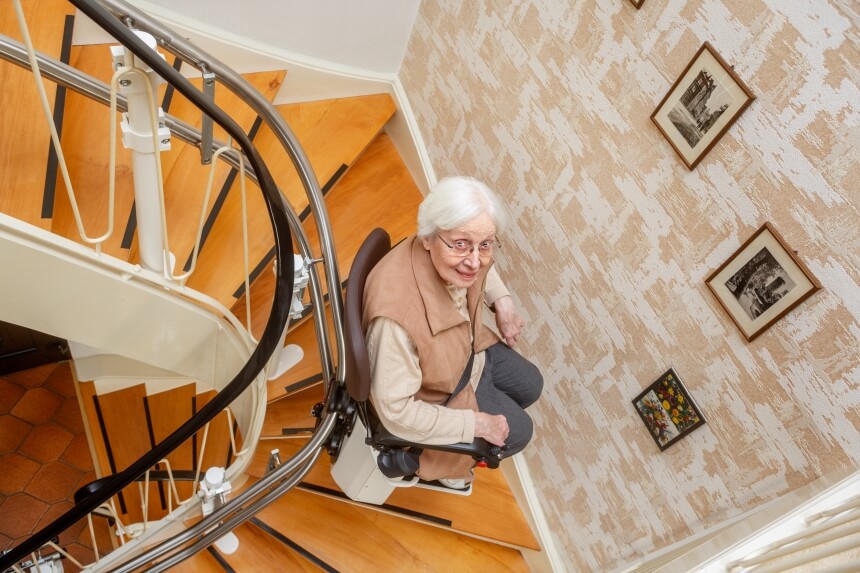
The safest method to navigate stairs without risk is a stairlift. Their electrically operated seats move up or down the stairs, providing mobility back to those at risk of falling in their own homes. This way, there is no need to move to a flat without stairs – seniors can continue to live in their familiar environment. Moreover, modern stairlift systems are already very space-saving and easy to install.
Nursing homes and care facilities are generally well-equipped to reduce the risk of falls, especially among dementia patients. Rooms and corridors in a good nursing home are designed to prevent tripping hazards. Additionally, tools are used to alert nursing staff to the behavior of dementia patients. Many institutions use radio safety mats, for example, which are placed in front of the nursing bed. If a dementia patient gets out of bed at night, for instance, they step onto the mat, which immediately sends a signal to the nursing staff to check on them.
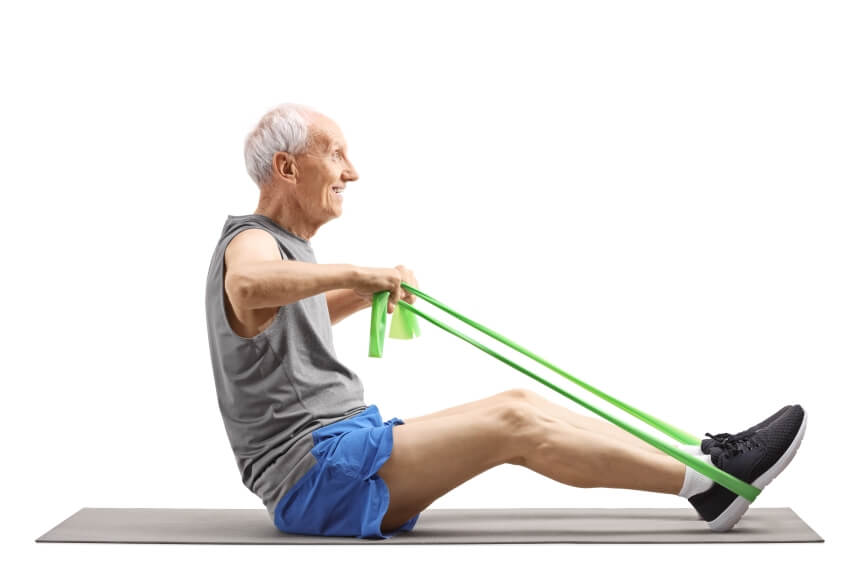
Measures that at-risk individuals can take themselves
You do not have to accept the decline in strength, balance, and coordination as you age. Many people lack the right exercise throughout their working lives. Sitting for hours at a desk is harmful to the body. In other cases, a dramatic deterioration begins at the start of retirement age, as people who have worked all their lives suddenly have nothing to do. Do not let it come to that!
Exercise is the key to maintaining coordination, strength, and reaction time into old age. It is not necessary to engage in competitive sports. Daily walks contribute a lot, as the human body is designed to move upright. Also, get up at home frequently to walk between rooms or walk at a leisurely pace while on the phone.
Simple exercises also help to train balance. For example, stand on one leg from time to time and maintain balance. Or stand on your tiptoes, hold the position for a while, and then lower your feet again. Such exercises can easily be incorporated into the evening routine in front of the television. After practicing standing for a while, you can still comfortably lie down on the couch.
Those who are more ambitious can also work with a so-called balance trainer. These are training devices with built-in instability – such as round discs with a ball underneath or balance pads that resemble partially inflated air mattresses. You can step onto these balance trainers and thus train the deep muscles in the lower abdomen, stomach, and back needed to keep us upright. Exercises where hands are supported on the training device are also possible.
Balance trainers can often be combined with "slow" sports such as Tai Chi or yoga, both of which are excellent methods for gentle strength and coordination training as well as cardiovascular strengthening. Those who participate in such courses also get to know like-minded people and can make new social contacts. Training together with others often strengthens motivation and makes it more enjoyable.
Yoga originates from Indian culture and combines physical exercises with breathing exercises. The body is brought into various positions, which are held for a while. These exercises are brought into line with deep breaths. There are different types and degrees of yoga – in some cases, the philosophical aspect of relaxation of the mind and body is paramount, while other variants place more emphasis on physical fitness. Even as a completely "unsporty" person, you can start with simple yoga for beginners and gradually increase it. The advantage of yoga is physical exercise with minimal stress, which can also have an energetic and relaxing effect through controlled breathing.
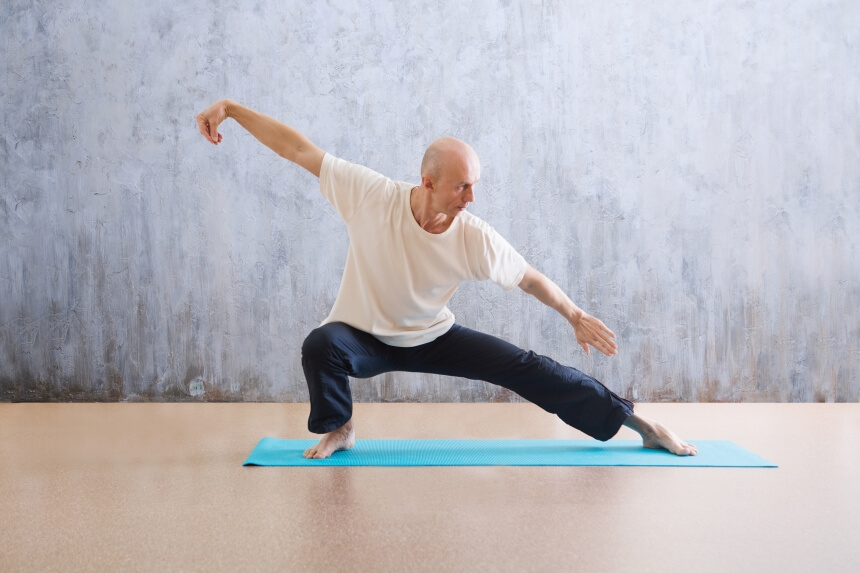
Tai Chi or "Taijiquan" originates from Chinese unarmed martial arts. However, this martial art has increasingly evolved into a relaxing exercise sport in modern times. Tai Chi involves flowing movements performed at a slow pace with a minimum of physical effort. These movements form "patterns" in the "fight" against an imaginary opponent. Controlled breathing also plays an important role in Tai Chi. The exercise movements are good for the joints and help maintain and improve limb mobility. Studies have shown that regular practice of Tai Chi also benefits cardiovascular health and mental well-being.
A particularly safe and gentle form of exercise is aquatic gymnastics. The water supports most of the body weight, allowing weakened or overweight individuals to exercise joints safely. Many swimming pools offer appropriate courses. These also have the advantage of allowing you to meet other people of your age with similar problems and make social contacts. Practicing together with like-minded people creates additional motivation, and you may find new friends with whom you can also do activities in your daily life.
Strength training not only builds new strength – active muscle tissue contributes to good blood circulation and ensures better energy consumption when you consume calories. Even carrying heavy objects can strengthen muscles, heart, and circulation. Shopping bags already become useful training tools. If you want to do more extensive exercises, you can use dumbbells in various shapes and sizes. Since these training weights come in many levels from light to very heavy, training can be adjusted to your capabilities and gradually increased over time.
Training with bands offers several advantages over traditional dumbbell training as you age. Fitness bands or Therabands allow for smoothly increasing and decreasing load without overwhelming current available physical strength. This type of training is especially gentle on the joints. In contrast, when training with dumbbells, you must move the full weight of the training device at all times – putting more strain on the joints.
It is advisable to maintain a certain level of regular exercise and effort from a young age. As you age, it becomes increasingly difficult to make up for lost fitness and strength. However, staying active gives you the best chance of maintaining your mobility well into old age. It is never too late to start exercising or physical activity.
However, it is advisable to consult your doctor before starting sports again in advanced age. Depending on your level of fitness or any conditions you may have, you may need a training program tailored to your needs. Many medical practices also offer geriatric preventive examinations to assess your risk of falling and provide you with specific advice for fall prevention.
Wearing special protective clothing can reduce the risk of injury in falls. Many manufacturers of medical specialty clothing already offer so-called hip protectors. These are underwear equipped with pads around the hip area. Since many falls in old age end with an impact on the hip area, wearing these hip protectors can reduce the likelihood of a femoral neck fracture or other hip injuries.
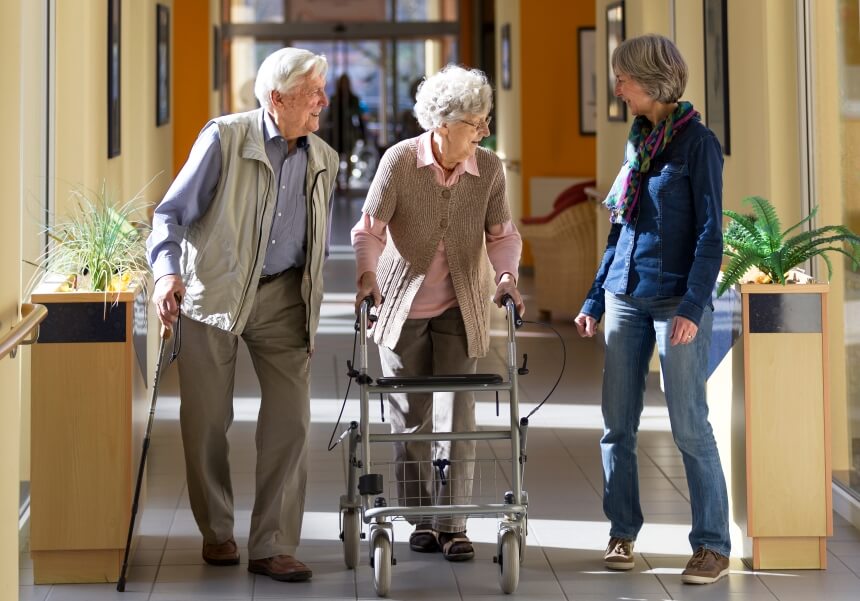
It is also advisable to use walking aids, as these enable participation in daily life and maintain independence for many seniors, even with physical limitations into old age. Depending on the extent of your mobility limitations – whether temporary or permanent – various walking aids are available:
- Walking sticks: The walking stick is the simplest option for bearing part of the body weight or relieving an injured leg. From a basic cane – which can also be a fashionable accessory – to adjustable forearm crutches (crutches), there are many variations. Non-slip rubber caps at the end of the stick provide secure grip when leaning on a walking stick. Walking sticks are useful when, for example, a foot or knee is injured, or there are only minor physical limitations. For significant mobility or strength loss, other walking aids should be chosen.
- Walking frames: Walking frames are designed for users to support themselves with their full weight. The sturdy frames are made of metal or durable plastic and can support up to 130 kilograms or more. Soft handles protect the hands, while non-slip rubber feet ensure stability on all surfaces. The walking frame is gripped with both hands and advanced with each step. In addition to everyday use, walking frames are also commonly used in physiotherapy – for example, when relearning to walk after surgery.
- Walkers and rollators: Walkers and rollators function similarly to walking frames but have wheels – making them mobile walking aids. Rollators can cover larger distances – such as for shopping. The wheels can be locked with parking brakes. Many models have fold-out seats for taking breaks at any time. Accessories such as shopping baskets or umbrella holders make it easier to carry items or attach umbrellas, enabling outdoor movement in all weather conditions.
- Wheelchairs: For those who cannot walk at all or hardly walk, a wheelchair is the best option. Whether electrically or manually operated – wheelchairs allow movement while seated in barrier-free indoor and outdoor spaces. Special safety belts for wheelchairs can be used to prevent weakened individuals from falling out of the wheelchair.
You can find various walking aids and accessories for crutches, walking sticks, and other supports in the online shop of Medicalcorner24®.
What to do if a fall occurs?
The best preventive measures cannot completely prevent a fall from happening. Therefore, you should have a clear plan for emergency situations and be prepared for the worst-case scenario. Seniors whose mental faculties are not too impaired by dementia, sedative medications, or the consequences of the fall itself can call for help using a mobile emergency call system they carry with them.

These emergency call systems typically consist of a simple button worn on a bracelet or around the neck. When the button is pressed, it activates a nearby alarm station that immediately contacts an emergency or care service. Helpers can promptly come to assist the senior who has fallen.
Even if you manage to get up on your own after a fall, it is usually advisable to seek medical attention. The consequences of some injuries may only become apparent after a delay. This applies, for example, if you hit your head – in such cases, the possibility of a concussion or worse consequences must be clarified. Also, fractures are not always immediately visible – a hairline fracture in the bone could initially feel like a painful bruise until it becomes a "proper" fracture under strain. Severe falls resulting in internal injuries can lead to tissue bleeding, which may worsen hours later. When in doubt, it is always better to err on the side of caution – for your own sake.
Conclusion:
It's impossible to completely eliminate falls in old age, but the risk can be reduced through fall prevention and an honest assessment of your own situation. By observing yourself closely and acknowledging that strength and coordination diminish over time, you can integrate precautions into your daily life without giving up your independence or feeling patronized. The consequences of a fall could significantly restrict your life. It's certainly better to use a walking aid than to lose the ability to walk altogether. Riding gently on a stair lift is surely a more pleasant experience than tumbling down the stairs.
At the latest, if you experience an unintentional fall, it's time for medical check-ups and a reconsideration of your daily routine. You will find that fall prevention does not restrict you as much as you might fear. Take care of yourself and stay with your family and friends, children, and grandchildren for a long time, continuing to participate in life. We sincerely wish this for you!



